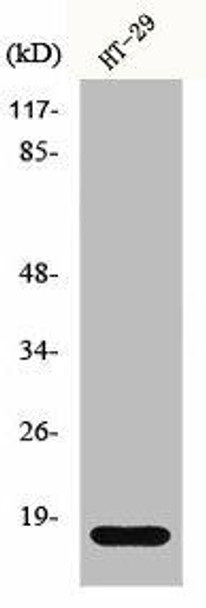Histone H2B Antibody (PACO00912)
- SKU:
- PACO00912
- Product Type:
- Antibody
- Reactivity:
- Human
- Mouse
- Host Species:
- Rabbit
- Isotype:
- IgG
- Applications:
- ELISA
- WB
- IHC
- IF
- Antibody Type:
- Polyclonal Antibody
- Conjugation:
- Unconjugated
Frequently bought together:
Description
| Antibody Name: | Histone H2B Antibody |
| Antibody SKU: | PACO00912 |
| Size: | 50ug |
| Host Species: | Rabbit |
| Tested Applications: | ELISA, WB, IHC, IF |
| Recommended Dilutions: | WB:1:500-1:2000, IHC:1:100-1:300, IF:1:200-1:1000 |
| Species Reactivity: | Human, Mouse |
| Immunogen: | synthesized peptide derived from the N-terminal region of human Histone H2B. |
| Form: | Liquid |
| Storage Buffer: | Liquid in PBS containing 50% glycerol, 0.5% BSA and 0.02% sodium azide. |
| Purification Method: | The antibody was affinity-purified from rabbit antiserum by affinity-chromatography using epitope-specific immunogen. |
| Clonality: | Polyclonal |
| Isotype: | IgG |
| Conjugate: | Non-conjugated |
| Synonyms: | HIST1H2BH; H2BFJ; Histone H2B type 1-H; Histone H2B.j; H2B/j |
| UniProt Protein Function: | H2B1H: a core component of the nucleoosome. The nucleosome, a basic organizational unit of chromosomal DNA, is octrameric, consisting of two molecules each of histones H2B, H2A, H3, H4. The octamer wraps approximately 147 bp of DNA. Nucleosomes wrap and compact DNA into chromatin, limiting DNA accessibility to the cellular machineries which require DNA as a template. Histones thereby play a central role in transcription regulation, DNA repair, DNA replication and chromosomal stability. DNA accessibility is regulated via a complex set of post-translational modifications of histones, also called histone code, and nucleosome remodeling.Protein type: DNA-bindingChromosomal Location of Human Ortholog: 6p22.2Cellular Component: cytoplasm; nucleoplasm; nucleusMolecular Function: DNA bindingBiological Process: nucleosome assembly |
| UniProt Protein Details: | |
| NCBI Summary: | Histones are basic nuclear proteins that are responsible for the nucleosome structure of the chromosomal fiber in eukaryotes. Two molecules of each of the four core histones (H2A, H2B, H3, and H4) form an octamer, around which approximately 146 bp of DNA is wrapped in repeating units, called nucleosomes. The linker histone, H1, interacts with linker DNA between nucleosomes and functions in the compaction of chromatin into higher order structures. This gene is intronless and encodes a replication-dependent histone that is a member of the histone H2B family. Transcripts from this gene lack polyA tails but instead contain a palindromic termination element. This gene is found in the large histone gene cluster on chromosome 6. [provided by RefSeq, Aug 2015] |
| UniProt Code: | Q93079 |
| NCBI GenInfo Identifier: | 7387739 |
| NCBI Gene ID: | 8345 |
| NCBI Accession: | Q93079.3 |
| UniProt Secondary Accession: | Q93079,Q4VB74, B2R541 |
| UniProt Related Accession: | Q93079 |
| Molecular Weight: | 13,892 Da |
| NCBI Full Name: | Histone H2B type 1-H |
| NCBI Synonym Full Names: | histone cluster 1, H2bh |
| NCBI Official Symbol: | HIST1H2BH |
| NCBI Official Synonym Symbols: | H2B/j; H2BFJ |
| NCBI Protein Information: | histone H2B type 1-H |
| UniProt Protein Name: | Histone H2B type 1-H |
| UniProt Synonym Protein Names: | Histone H2B.j; H2B/j |
| Protein Family: | Histone |
| UniProt Gene Name: | HIST1H2BH |
| UniProt Entry Name: | H2B1H_HUMAN |








